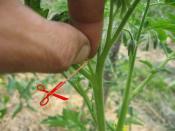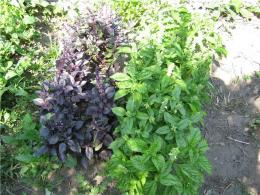Search
Login
Recommended
Do-it-yourself seasonings and spices
Many amateur gardeners are engaged in the creation of small mini-gardens, while exhibiting a variety of design abilities, automatically included in the overall design of the garden landscape.
Content
- Selection of spicy plants
- Tool for work
- We plant seedlings
- Picking seedlings
- Choose the shape of the garden
- Improving soil structure
- Foundation building
- Seasoning filling video
Selection of spicy plants
To create a beautiful garden garden with spicy plants used by hostesses as seasonings in their kitchen, we select an assortment, purchase seeds and sort them by planting time, into perennial and annual, according to color scheme.
For our garden garden we chose annual condiments:
- purple basil;
- aromatic green basil;
lemon basil;
- clove basil;
- garden marjoram;
- mustard leaf freckle;
- coriander (cilantro);
- curly endive salad;
- celery leaf.
In addition to annuals, we introduce:
- perennial thyme;
- perennial hyssop.
Tool for work
Garden shovel.
Rake.
Tanks for seedlings.
Buckets.
Mini spatula.
Mini rake for seedlings.
We plant seedlings
Seedlings are grown for all annual plants that have a relatively long development period from sowing to flowering and, in addition, are so sensitive to cold weather that they can be planted on open soil only after the last frost. Having bought the seeds of seasonings and spices, carefully study the instructions, it describes in detail the planting time, soil quality, the size of the future plant.
In accordance with the size of the future plant, plan your garden for planting seedlings in the garden.
Keep in mind that in the center or in the background, plant higher plants, in front of them, as they decrease, the following plants.
For seedlings, the tray is filled almost to the brim with planting soil, the earth is compacted and moistened. Seeds are evenly distributed over the planting ground. A thin layer of earth or sand is poured on top and compacted again.
It is possible that some varieties have light-like seeds (indicated on the seed packaging); these seeds do not need to be covered with earth.
Now you need to water the landing. The tray is closed with a plastic lid or wrapped with foil and placed in a warm place.
After the emergence of green shoots, the trays can be put in a cooler place, but with good lighting.
It is necessary to constantly monitor soil moisture.
Picking seedlings
When the first true leaves appear on the stem, the plants must be dived.
To do this, water the land, after the water is absorbed (this will facilitate the extraction of plants from the ground and help to avoid damage to the roots) using a special dive stick (two toothpicks can be used), young plants are extracted from the ground.
Too long central root must be cut, shortened to improve branching of the root system.
After that, small plantlets are planted one at a time, or in a small group in separate pots or a separate fairly spacious tray, keeping a small distance for the full development of seedlings.
After a pick, the plants are watered and subsequently produce constant moisture control.
Choose the shape of the garden
The mini-garden can be decorated in the form of a rectangular, square shape or be a circle divided into beds - segments, it can look like a small flowerbed of irregular shape.
But the bed of spicy crops, regardless of shape, should be well lit by the sun's rays, since even a small penumbra will slow the growth of perennials, thereby depriving you of early greens to the table.
Improving the soil
For garden crops, a very important point is the fertility of the soil and its permeability. But since the kindergarten is usually tied to the buildings of a summer kitchen or a gazebo, naturally, in such a place the soil is rarely of good composition and almost always requires improvement of the structure, for which sand, clay or peat is added.
If a spicy plant has to be planted in low areas, it is necessary to arrange drainage. To do this, a drainage groove is dug around the bed.
To increase soil fertility, it is very good to add ash, compost and humus. Fertilizing crops, do not forget to adhere to the principles of organic farming, as you will eat the grown products yourself.
If the bed of spicy plants is large enough, flat stones will be good helpers. They will play the role of separators of different types of herbs, as well as provide good access when cultivating the land. The stones must be well laid, withstand the load, they will serve well on cool nights, give the earth the heat accumulated during the day.
Foundation building
To create a beautiful flower bed, you need to choose the base plants, and not necessarily edible.
Coniferous or deciduous shrubs planted in the center look spectacular.
In order to emphasize the decorativeness of the seasoning beds, it’s good to add cute country-style little things (a car with flowers, a cart wheel, beautiful driftwood).
Use planted in pots or flowerpots ornamental cabbage, a bush of chrysanthemums or nasturtium.
If the garden bed is created in an angular shape, there is a wall or support behind, you can plant and direct the lashes of cucumbers vertically.
Seasoning filling
Depending on the planted assortment of plants planted, a garden garden may be a miniature copy of garden beds, and may resemble a flower garden.
When selecting plants for a seasoning garden, a beautiful role is played by the beautiful color and shape of the leaves.
This problem, at present, can be easily solved with the help of various varieties of salads with purple leaves (Lolo Rossa salad), spices with purple leaves (purple basil), spices with variegated leaves (mustard leaf Freckle).
All these plantings turn the garden into colorful flower beds. In our flower bed you can not do without flowering plants, many of them have medicinal properties and beautiful flowers, such as calendula, nasturtium, marigolds.
Of the spicy cultures, the flowering perennials, thyme perennials, hyssop, oregano, chives, and slime onions delight in friendly flowering.
Tarhun and lovage winter well in central Russia, combining wonderfully with hyssop and celery.
As the edging of our bed of spices, strawberry Cinderella or the purple plantain variety are perfect.





